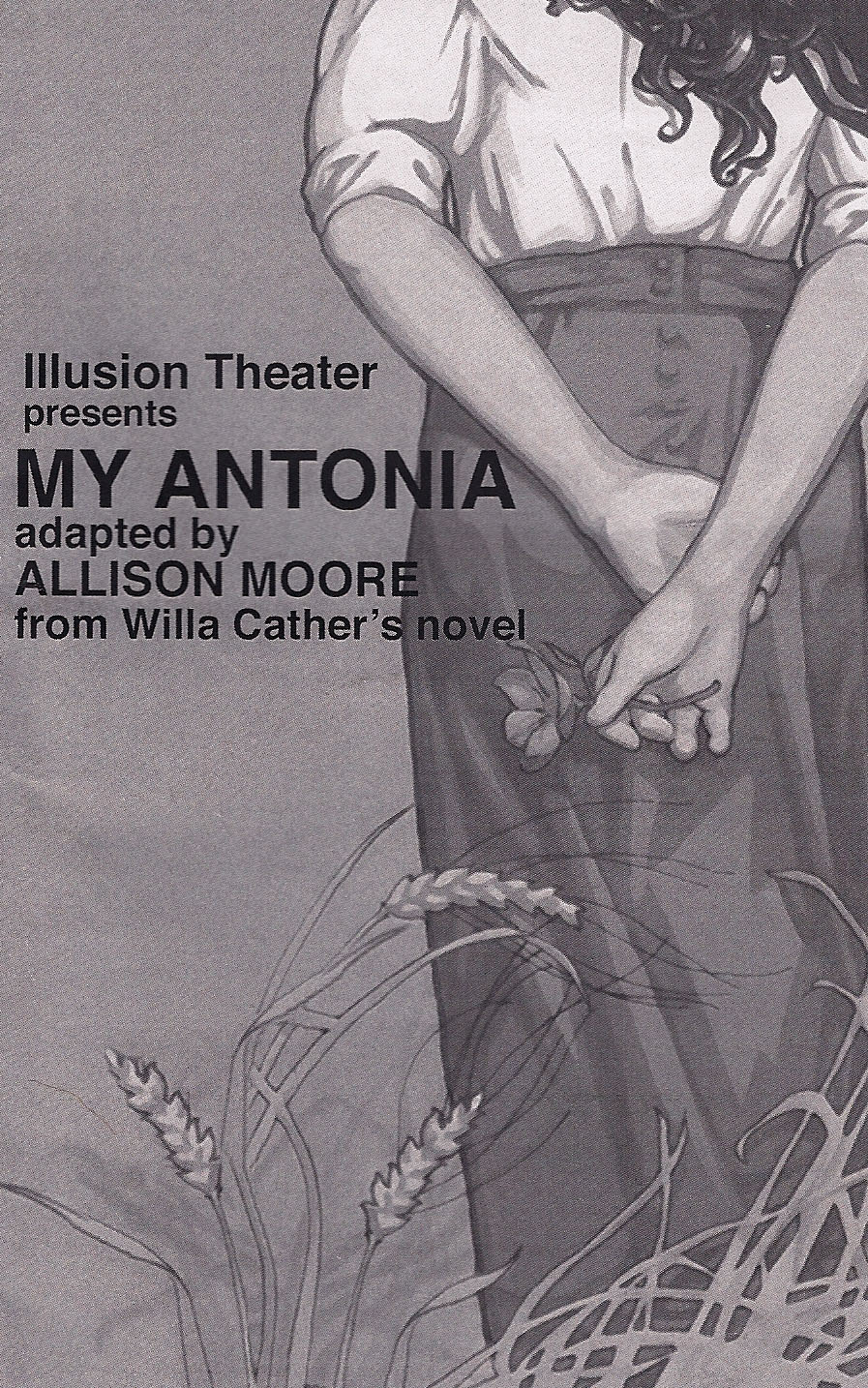Cather’s Prairie Classic, from Page to Stage
Britt Aamodt reviews "My Antonia," a new play by Allison Moore, directed by Illusion Theater's Michael Robins, calling the classic novel's translation to the stage a near-impossible achievement, but one the ensemble has pulled off ably.



THE STAGE IS DARK. Then, from the wings, string instruments pick up a driving rhythm. A piano thumps in. The chords, the beat — everything about the small ensemble imitates the sound of a train plunging through open country. A light plays stage right. A man appears in the light, seated in what looks like a train compartment, directing the beam of a magic lantern against a screen, on which projects an image of tall grass prairie.
The train passenger is Jim Burden, the narrator of Willa Cather’s classic pioneer novel My Ántonia, and tonight he and a packed house at Illusion Theater in Minneapolis are traveling through the Great Plains and turning back the clock — twenty years for Burden, more than a hundred years for the audience — to the pioneering days of Nebraska.
Playwright Allison Moore‘s new stage adaptation of My Ántonia drives this amazing journey. The script is abetted by Michael Robins’s direction, Roberta Carlson’s compositions, and a cast and crew that have somehow achieved the impossible — compressing an episodic novel, never intended for the stage, into a one-and-a-half-hour drama whose very simplicity communicates the wide open spaces of Cather’s beloved Nebraska and the deep human feeling of her characters.
Adapting Cather
Willa Cather (1873-1947) was born in Virginia, but as a girl moved with her family to Nebraska. Though Cather eventually relocated to the East Coast, she never lost her fascination with the Great Plains and the immigrant families who struggled to survive in that harshly beautiful landscape. Cather published My Ántonia in 1918 and always considered it her greatest novel.
My Ántonia follows the stories of several immigrant families who move to rural Nebraska to start anew as American pioneers. Jim Burden arrives in Black Hawk, Nebraska, on the same train that carries the Shimerdas, a Bohemian family whose eldest daughter is Ántonia. Ten-year-old Jim and the slightly older Ántonia form a lasting bond which, for Jim, borders on love. That relationship remains the constant in a novel that spans two decades of their lives, from a shared childhood to separation and eventual reunion twenty years later, when Jim returns to find Antonia married with ten children.
The playwright says she immediately identified with Cather’s relationship to place. “I grew up in Texas and I couldn’t wait to leave,” Moore says. “It wasn’t until I left that I realized how much the landscape had shaped my point of view and imagination.”
Moore, whose plays have been staged around the country, never set out to adapt Willa Cather. “One day, I randomly picked up My Ántonia at the library. I read it during one of those horrible Minnesota winters, and it was such an amazing story. I remember thinking: Why haven’t I read Cather before?“
Coincidentally, around this time, Illusion Theater cofounder Michael Robins approached Moore with the idea of adapting My Ántonia for the stage. Robins had always appreciated Cather; he’d worked on a play based on the author’s life, and another loosely based on her novel, The Song of the Lark. The trouble with adapting Cather, he says, has been that much of her work is under copyright. “But the minute I knew My Ántonia was going into the public domain, I contacted Allison,” says Robins. “I’d already done two projects with Allison and knew she was a real collaborator. I wanted to work closely with someone on this.”
A Love Story
Playwright and director dove into the novel and then immediately hit a snag. “We only had about a million hiccups along the way,” says Moore. “My Ántonia is episodic. There’s no traditional dramatic arc, because what Cather’s doing, essentially, is creating a world.”
They tossed out whole sections of the book. Finally, says Robins, “we both realized that the core story, however odd, is the love story between Jim and Ántonia.” The couple’s story, he says, is odd because the relationship never quite takes off. Jim never gets the girl, and the girl eventually disappears into a weather-beaten mother of ten. But Jim’s memory lingers, as does his nostalgic love for the girl and the land that brought them together.
________________________________________________________
My Ántonia is as relevant today as it was in 1918 — it’s a classic American frontier story, with characters who embody an enduring theme in Cather’s work, inner strength and the will to persevere.
________________________________________________________
Moore and Robins decided to use two Jim Burdens for their production. The older Jim, played by Brian Goranson, functions as the play’s narrator: he’s the passenger we first see, taking the train back to Nebraska, whose tale is told as a flashback, projected by his magic lantern on a screen. He and the audience watch together as the young Jim (John Catron) and Ántonia (Katie Guentzel) step out of memory and emerge on the platform where they’d met twenty years before.
“The actors are amazing,” says Moore. “They’ve lived and breathed these characters for a very long time. There have been fifteen different versions of several different scenes. As a result, their work has become very deep.” Guentzel, Catron, and Angie Haigh — who plays both Ántonia’s mother and Jim’s alternate love interest, Lena Lingard — have been with the project since 2008.
Adding to the performances is the music composed by Roberta Carlson. Carlson, who has composed for the Children’s Theatre Company and Jungle Theater, crafted her ensemble around a violin, “because that’s the instrument Mr. Shimerda plays.” Carlson’s evocative score nicely echoes the spare but effective set design created by Dean Holzman; her musical passages sometimes offer specific support for the scene at hand — mimicking a train, a grasshopper, the patter of rain; her compositions also serve to set the mood, evoking time and place with Americana, ragtime and Czech folk songs.
Moore, Robins, and Carlson all insist that My Ántonia is as relevant today as it was in 1918. It’s a classic American frontier story: the poor immigrant girl stays behind in her rural hometown, while the boy she loves escapes his modest, Midwestern upbringing by heading out East, to a good school and a better life. Both characters embody an enduring theme in Cather’s work, inner strength. “We’re going through hard times in our country right now,” says Carlson. “What do you have, inside, that gives you strength, and what gives you belief in the future?” For Ántonia and Jim, the answer lies in the flat Nebraska landscape and the harsh contours of frontier life, in the circumstances which repeatedly test their courage but never break their will.
________________________________________________________
Noted performance details:
My Ántonia, adapted for the stage by Allison Moore and directed by Michael Robins, with music by Roberta Carlson, runs through March 20, at the Illusion Theater in downtown Minneapolis.
________________________________________________________
About the author: Britt Aamodt‘s book on Minnesota’s contemporary cartoonists (Superheroes, Strip Artists & Talking Animals) is coming out fall 2010 from the Minnesota Historical Society Press.